Full Text Searchable PDF User Manual
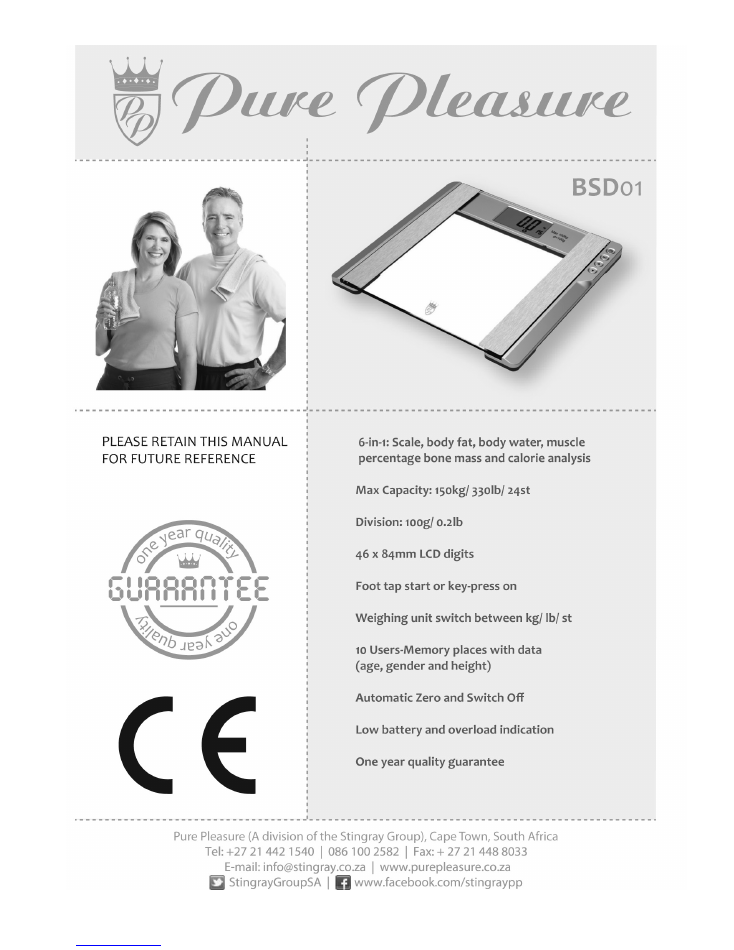
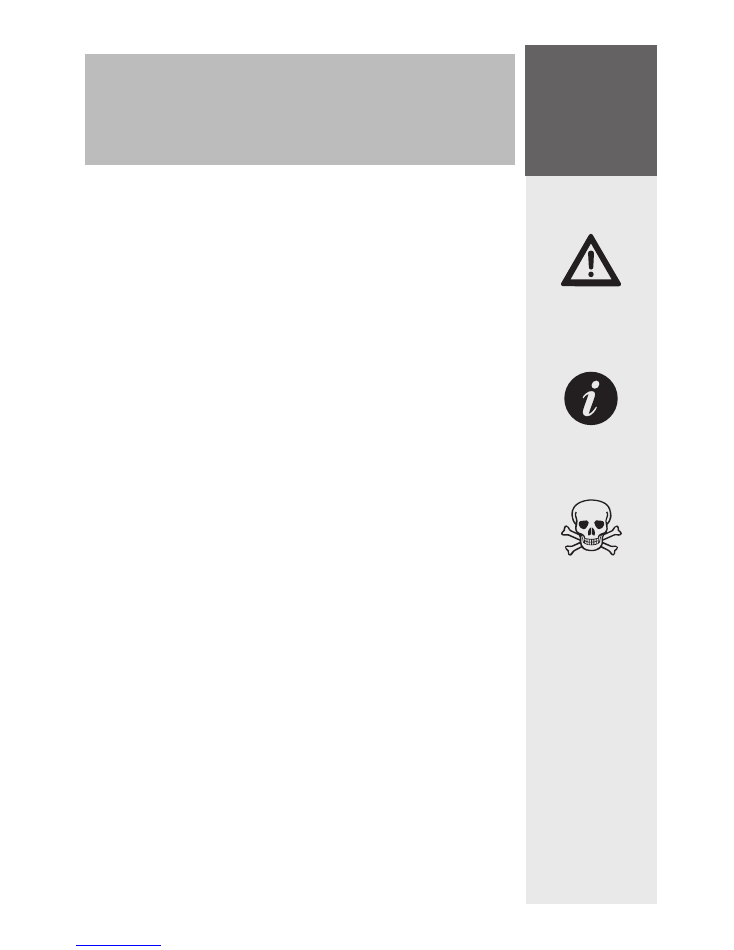
2
3
3
3
4
4
4
5
6
7
8
11
11
11
12
12
12
13
13
GENERAL
HOW DIAGNOSTIC SCALES WORK
HOW TO WEIGH YOURSELF CORRECTLY
GENERAL
LIMITATIONS
OPERATING INSTRUCTIONS
BATTERIES
MEASURING YOUR WEIGHT
SETTING USER DATA
TAKING MEASUREMENTS
INTERPRETING YOUR RESULTS
AUTOMATIC SWITCH OFF
OVERLOAD INDICATOR
INCORRECT MEASUREMENT
CARE
ADDITIONAL INFORMATION
SPECIFICATIONS
POWER
SUPPLY
WARRANTY
INDEX
GLOSSARY
OF SYMBOLS
FOUND
IN THIS MANUAL
CAUTION
INFORMATION
DANGER
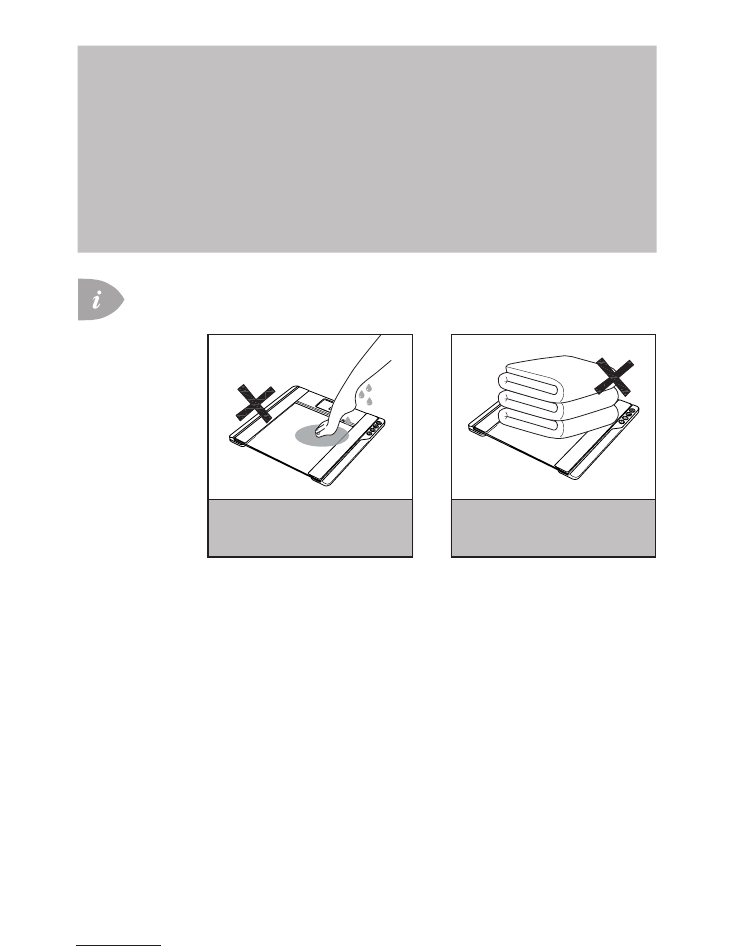
GENERAL
•
This scale must not be used by persons with medical implants
(e.g. pacemakers). Their function could be impaired.
•
DO NOT use during pregnancy. Inaccurate measurements may be caused
by the amniotic fluid.
•
Protect the scale against impact, moisture, dust, chemicals, major
temperature fluctuations and keep it away from heat sources.
•
Batteries must not be charged or reactivated by other means, taken apart,
thrown into a fire or short circuited.
•
Repairs may only be done by Pure Pleasure Customer Service or authorized
dealers. Failure to follow this will void the warranty.
•
This device is only for private use and is not intended for medical or
commercial purposes. Please note that the scale is not calibrated for
professional medical applications.
DO NOT place any objects on the
scale when not in use.
DO NOT step on the scale with wet
feet or when the scale surface is
damp - there is a danger of slipping.
Dear Customer,
Thank you for purchasing a Pure Pleasure product. You can be rest assured that our
electric blankets and scales have been designed to meet international standards and
that you have purchased a quality product.
Please read these instructions carefully and keep them for future use. Be sure to share
them with other users and always follow the information they contain.
2

•
Please dispose if the appliance in accordance with the Directive on Waste
Electrical and Electronic Equipment
(WEEE)
. In case of queries, please
contact the municipal authorities responsible for waste disposal in your
area.
Keep packaging materials away from children.These are a suffocation risk.
Batteries are very dangerous if swallowed. Keep batteries and scale out of
reach of small children. If batteries are swallowed, seek medical help
immediately.
HOW DIAGNOSTIC SCALES WORK
This scale operates according to B.I.A (bioelectric impedance analysis). This enables
physical relationships to be measured within seconds by means of an undetectable,
completely harmless electric current. The body fat percentage and other physical
measurements of the body can be determined by measuring the electrical
resistance (impedance) and the inclusion of these in a calculation of constants and
individual parameters (age, height and gender).
Muscle tissue and water have good electrical conductivity, and therefore lower
resistance. Bones and fatty tissue, on the other hand, have low conductivity, as fat
cells are bone conduct hardly any current as a result of their very high resistance.
Please be aware that values obtained from the diagnostic scale represent only an
approximation of actual analytical medical data. Only a specialist physician can accu-
rately determine body fat, body waster muscle percentage and bone structure using
medical procedures. This scale should only be used for trend analysis.
HOW TO WEIGH YOURSELF CORRECTLY
If possible, always weigh yourself at the same time of day (ideally in the morning),
after going to the toilet, on an empty stomach and without clothes to achieve
comparable results. Wait approximately 15 minutes after getting up in the morning
to allow the water in the body to distribute.
GENERAL
For diagnostic measurement purposes, body fat can only be measured
when barefoot and with the soles of the feet slightly moist.
Completely dry soles can result in unsatisfactory measurements due to
inadequate conductivity.
Stand still during the measurement.
Wait a few hours after abnormal strenuous activity.
3

LIMITATIONS
When measuring body fat and other values, deviating and implausible
results may occur in:
•
children under approximately 10 years,
•
competitive athletes and body builders,
•
pregnant women,
•
persons with fever, undergoing dialysis treatment or with symptoms
of edema or osteoporosis,
•
persons taking cardiovascular medication,
•
persons taking vascular dilating or vascular constricting medication,
•
persons with considerable anatomic deviations of the legs in rela-
tion to total body size (length of the legs considerably shortened or
lengthened).
OPERATING INSTRUCTIONS
This scale has been designed to determine the weight of human beings.
The scale can measure up to 150kg. For weight measurement and bone mass
measurement, the results are shown in 100g increments. The measuring results of
the body fat, body water and muscle percentage are shown in 0.1% increments..
BATTERIES
If present, pull the battery insulating strip off the battery compartment
cover or remove the battery’s protective film and insert the batteries
according to the polarity. If the scale fails to operate, remove the batteries
completely and insert them correctly again.
Battery replacing indicator: When the batteries need replacing,
the “LO” message will appear on the display.
Please open the battery cover, remove the batteries carefully from the
battery compartment by drawing them sideways out from under the
contacts. DO NOT bend the contents back while you do this, or they may
break. Dispose of the old batteries in an environmentally friendly manner.
If you do not intend to use this scale for a long period of time, we
recommend removing the batteries before storing the scale.
4
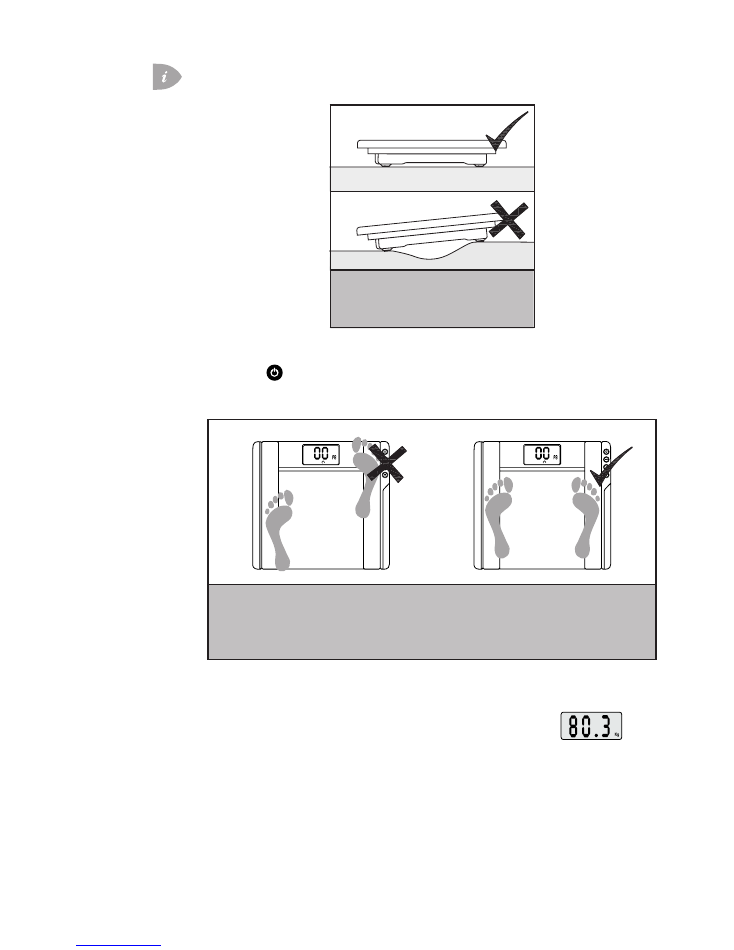
cm
cm
MEASURING YOUR WEIGHT
Press quickly and forcefully with your foot on the platform of your scale or
press the button. (DO NOT stand on the scale). Wait for the display to
display “0,0” .The scale is now ready to measure your weight.
Wait while the scale computes your weight.
Your correct weight will then be displayed as follows:
Your scale rounds up or down to the nearest 100g. If you weigh yourself
twice and get two different readings, your weight is the average of the
two.
5
Only use the scale on a hard and
even surface. Weighing on a carpet
will affect the accuracy of the scale.
Stand squarely and gently on the scale distributing your weight evenly
between your feet.
DO NOT lean backwards and/or forwards.
NEVER step onto the outer edge of the scale as this could cause the scale to tip.
80kg 300g
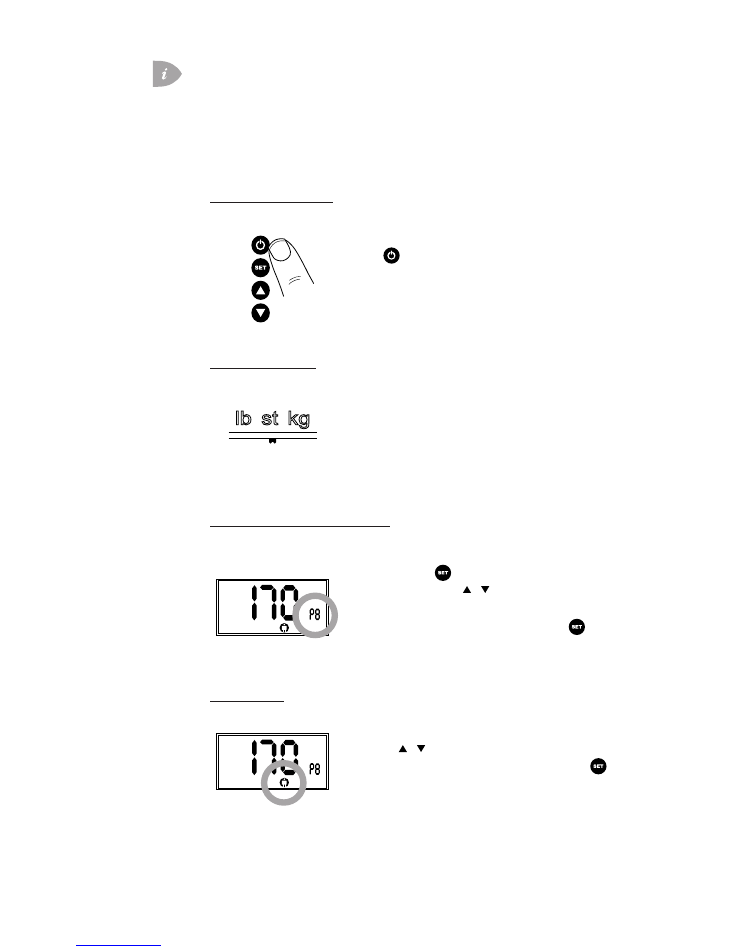
SETTING USER DATA
To measure your body fat percentage and other physical data, you must
enter your personal user parameters. The scale has 10 memory positions
in which you and other members of your household can save and recall
personal settings.
1. Turn on the power
Press button to turn on the unit.
The unit will confirm activation; the personal data
number last used will appear.
2. Selector Switch
Use the selector switch on the bottom of the scale
to select a weight to use: Metric (
kg
), Pounds (
lb
),
or Stones (
ST
).
3. Select a Personal Data Code
First press the button – the personal data code
will flash. Press the / buttons to select a
Personal data code. Once you reach the Personal
data code you wish to use, press the button to
confirm.
4. Select Sex
Use the / buttons to scroll to appropriate
male/female settings and then press the button
to confirm.
6
cm
cm
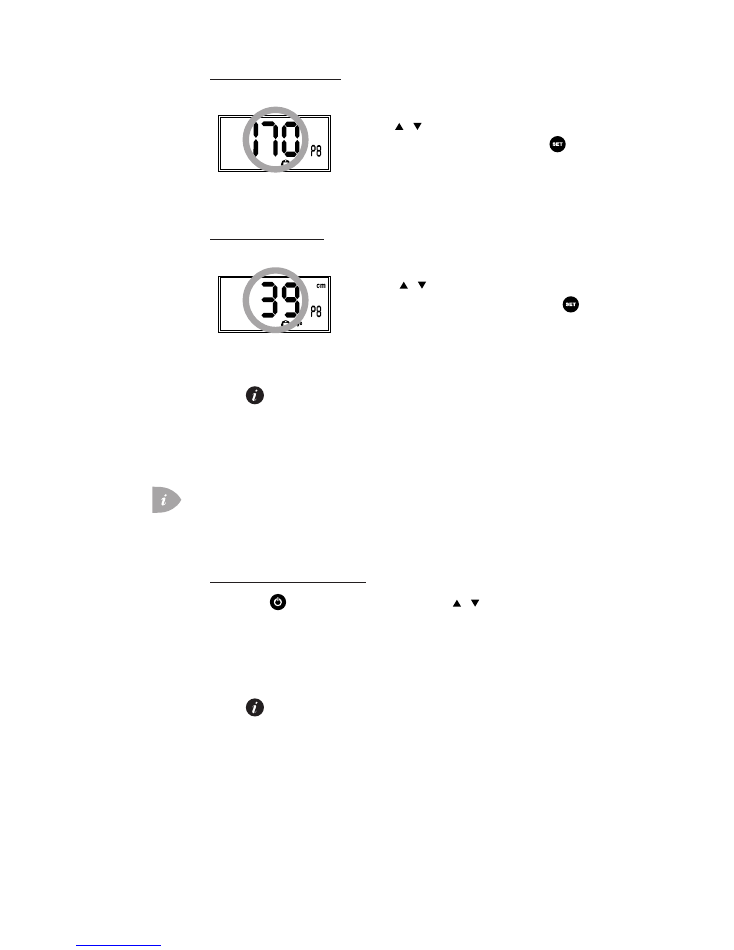
5. Specify your Height
Use the / buttons to scroll to specify your height
in centimeters and then press the button to
confirm. (Range of user height is 100cm – 220cm).
6. Specify your Age
Use the / buttons to scroll to specify your age.
When you reach your age, press the button to
confirm (range of user age is 10 – 90 years).
NOTE:
If you make a mistake before you have finished
programming it, repeat the steps from Select a Personal data
Code.
TAKING MEASUREMENTS
After all parameters have been entered, you can now measure your weight,
body fat and all the other data.
Select Personal Data Code
Press the button to turn on. Use the / buttons to select your
Personal data code. The display will show the programmed data.
DO NOT step on the scale until the “0.0” appears on the display.
Step on the scale with bare feet and make sure you are standing still on the
stainless steel electrodes.
IMPORTANT
: There may be no contact between feet, legs,
calves and thighs. If there is the measurement may not be
performed accurately.
7
cm
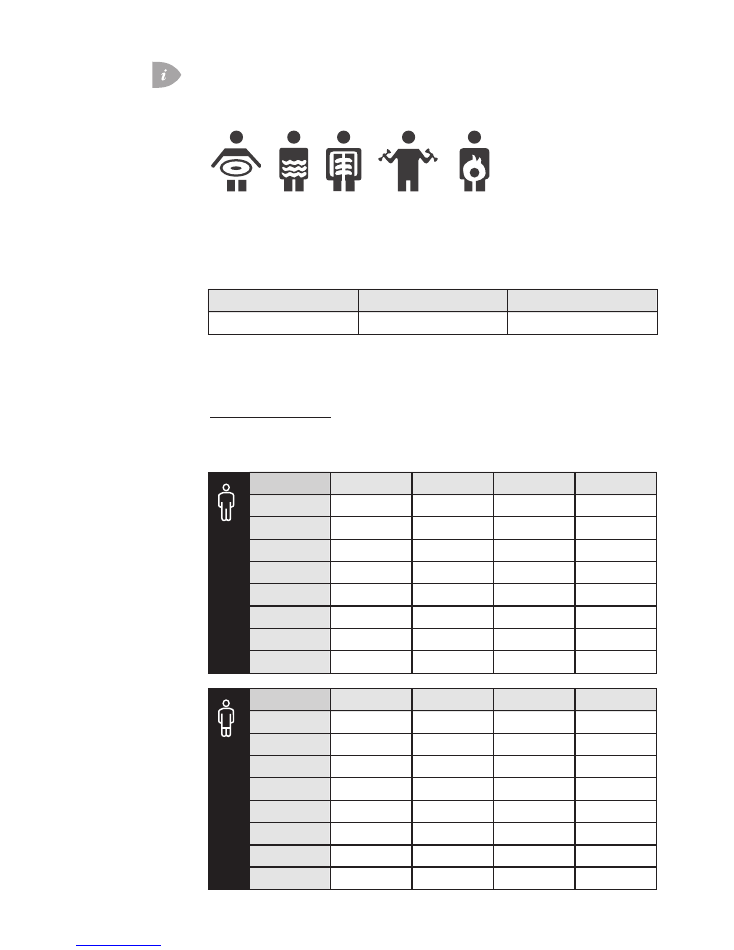
INTERPRETING YOUR RESULTS
In order of appearance on screen after your weight is displayed:
Your weight is compared with the BMI (Body Mass Index). It is calculated
using the following formula: BMI = ( Weight in Kilograms / ( Height in
Meters x Height in Meters ) )
Note that with very muscular physiques (body builders), the BMI
interpretation will show overweight. The reason for this is that no account
is taken of well above average muscle mass in the BMI formula.
Body fat percentage
The following body fat percentages are for guidance only (contact your
physician for further information).
Underweight
Normal weight
Overweight
<20
20-25
>25
Age
Very Good
Good
Average
Poor
10-14
<11%
11-16%
16.1-23%
>23.1%
15-19
<12%
12-17%
17.1-23%
>23.1%
20-29
<13%
13-18%
18.1-23%
>23.1%
30-39
<14%
14-19%
19.1-24%
>24.1%
40-49
<15%
15-20%
20.1-25%
>25.1%
50-59
<16%
16-21%
21.1-26%
>26.1%
60-69
<17%
17-22%
22.1-27%
>27.1%
70-90
<18%
18-23%
23.1-28%
>28.1%
Age
Very Good
Good
Average
Poor
10-14
<16%
16-21%
21.1-26%
>26.1%
15-19
<17%
17-22%
22.1-27%
>27.1%
20-29
<18%
18-23%
23.1-28%
>28.1%
30-39
<19%
19-24%
24.1-29%
>29.1%
40-49
<20%
20-25%
25.1-30%
>30.1%
50-59
<21%
21-26%
26.1-31%
>31.1%
60-69
<22%
22-27%
27.1-32%
>32.1%
70-90
<23%
23-28%
28.1-33%
>33.1%
8
M
ALE
FEM
ALE
Fat
Water
Calories
Bone
Muscle
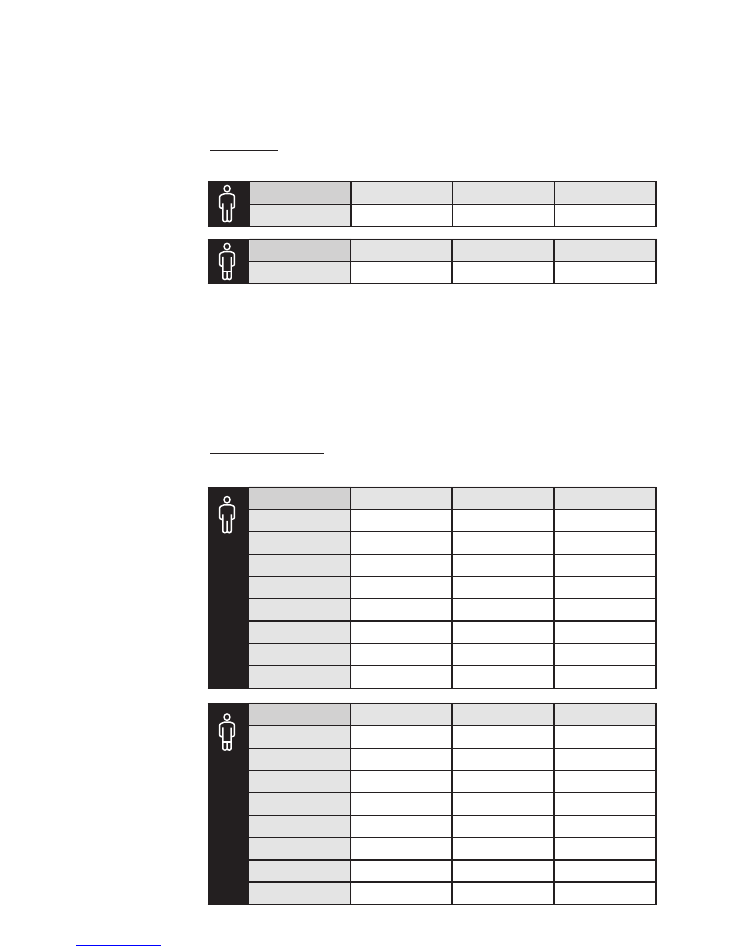
A lower value is often found in athletes. Depending on the type of sports,
training intensity and physical constitution, values may result which are
below the recommended values stated. It should, however, be noted that
there could be a danger to health in the case of extremely low values.
Body water
The body water percentage is normally within the following ranges:
Body fat contains relatively little water. Therefore persons with a high body
fat percentage have body water percentages below the recommended
values. With endurance athletes, however, the recommended values could
be exceeded due to low fat percentages and high muscle percentage.
Body water measurement with this scale is not suitable for drawing
medical conclusions, for example concerning age related water retention.
If necessary ask your physician.
High body water percentage should be the aim.
Muscle percentage
The normal percentage of muscle is in the following ranges:
Age
Poor
Good
Very Good
10-90
<50%
50-65%
>65%
Age
Poor
Good
Very Good
10-90
<50%
50-65%
>65%
Age
Poor
Average
Good
10-14
<44%
44-57%
>57%
15-19
<43%
43-56%
>56%
20-29
<42%
42-54%
>54%
30-39
<41%
41-52%
>52%
40-49
<40%
40-50%
>50%
50-59
<39%
39-48%
>48%
60-69
<38%
38-47%
>47%
70-90
<37%
37-46%
>46%
Age
Poor
Average
Good
10-14
<36%
36-43%
>43%
15-19
<35%
35-41%
>41%
20-29
<34%
34-39%
>39%
30-39
<33%
33-38%
>38%
40-49
<31%
31-36%
>36%
50-59
<29%
29-34%
>34%
60-69
<28%
28-33%
>33%
70-90
<27%
27-32%
>32%
9
M
ALE
FEM
ALE

Bone mass
Like the rest of our body, our bones are subject to natural development,
degeneration and the ageing process. Bone mass increases rapidly in
childhood and reaches its maximum between 30 and 40 years of age.
Bone mass reduces slightly with increasing age. You can reduce this
degeneration somewhat with healthy nutrition (particularly calcium and
vitamin D) and regular exercise. With appropriate muscle building, you can
also strengthen your bone structure.
Note that this scale will not show you the calcium content of your bones,
but will measure the weight of all bone constituents (organic substances,
inorganic substances and water).
ATTENTION
: Please do not confuse bone mass with bone
density. Bone density can be determined only by means of a
medical examination. It is therefore not possible to draw
conclusions concerning changes to the bones and bone
hardness (e.g. osteoporosis) using this scale.
Little influence can be exerted on bone mass, but it will vary
slightly within the influencing factors (weight, height, age,
gender).
Results in relation to time
Note that it is only the long-term trend which counts. Short period
fluctuations in weight over a few days are mostly the result of a loss of
fluid.
The interpretation of the results will depend on changes in your overall
weight and body fat, body water and muscle percentages, as well as on
the period during which these changes take place. Rapid changes within
days must be distinguished from medium term changes (over weeks)
and long term changes (months). A basic rule is that short term changes in
weight almost exclusively represent changes in water content, whereas
medium and long term changes may also involve the fat and muscle
percentages.
•
If your weight reduces over the short term, but your body fat
percentage increases or remains the same, you have merely lost water
– e.g. after a training session, sauna session or a diet restricted only to
rapid weight loss.
•
If your weight increases over the short term, but your body fat
percentage falls or stays the same, then you could have built up
valuable muscle mass.
•
If your weight and body fat percentage fall simultaneously then your
diet is working – you are losing fat mass. Ideally you should support
your diet with physical activity. By these means, you can increase your
muscle percentage over the medium term.
10
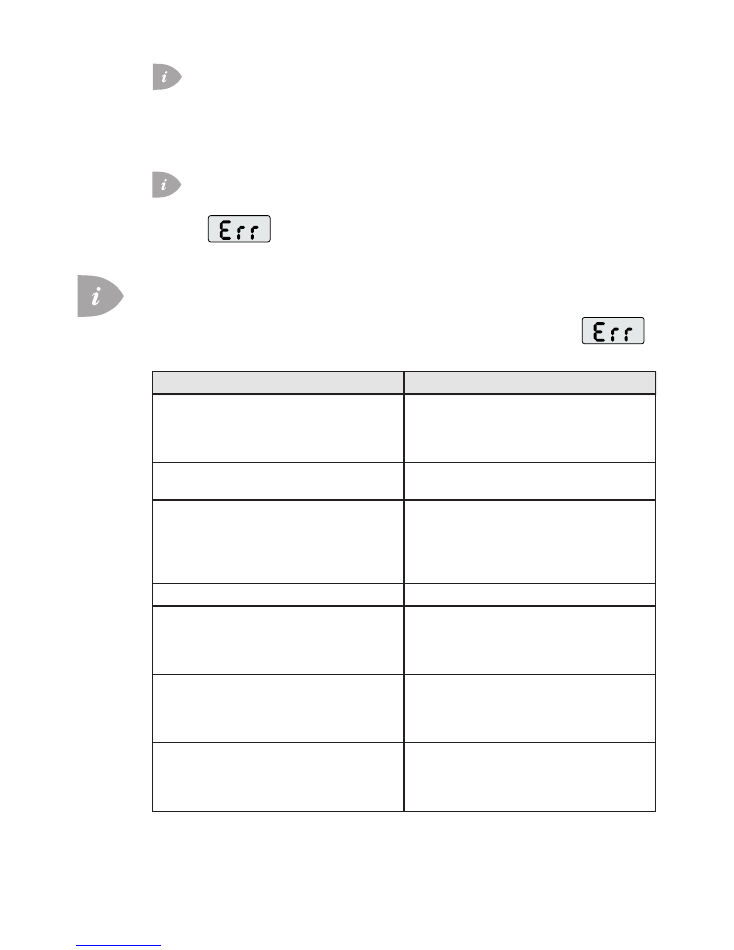
AUTOMATIC SWITCH OFF
When you step off the scale, it will automatically switch off.
(If no weighing takes place while the zero is being displayed, the scale
switches off automatically after approximately 10 seconds).
OVERLOAD INDICATOR
When the scale is overloaded (weight exceeds 150kg), this
error message will appear on the screen.
INCORRECT MEASUREMENT
If the scale detects an error during measurement, this is indicated with
11
Possible cause of error
Remedy
The scale was not activated before you stood
on it. If you stand on the scale before “0.0”
appears on the display, the scale will not
function properly.
Activate the scale correctly and repeat the
measurement.
The maximum capacity of 150kg was
exceeded
Weigh only the maximum permissible
weight.
The electrical resistance between the
electrodes and the soles of the feet is too
high (e.g. in the case of thick calluses).
Repeat the measurement barefoot.
If necessary, moisten the soles of your feet
slightly. If necessary, remove the calluses
form the soles of your feet.
You are standing unsteadily on the scale.
Keep still while standing on the scale.
The fat percentage is outside the measurable
range (less than 5% or greater than 50%)
Repeat the measurement barefoot or, if
necessary, moisten the soles of your feet
slightly.
Be careful not to use the scale with wet feet.
The water percentage is outside the
measurable range (less than 36% or greater
than 70%)
Repeat the measurement barefoot or, if
necessary, moisten the soles of your feet
slightly.
Be careful not to use the scale with wet feet.
The muscle and bone percentages are
outside the measurable range (age and
gender related)
Repeat the measurement barefoot or, if
necessary, moisten the soles of your feet
slightly.
Be careful not to use the scale with wet feet.
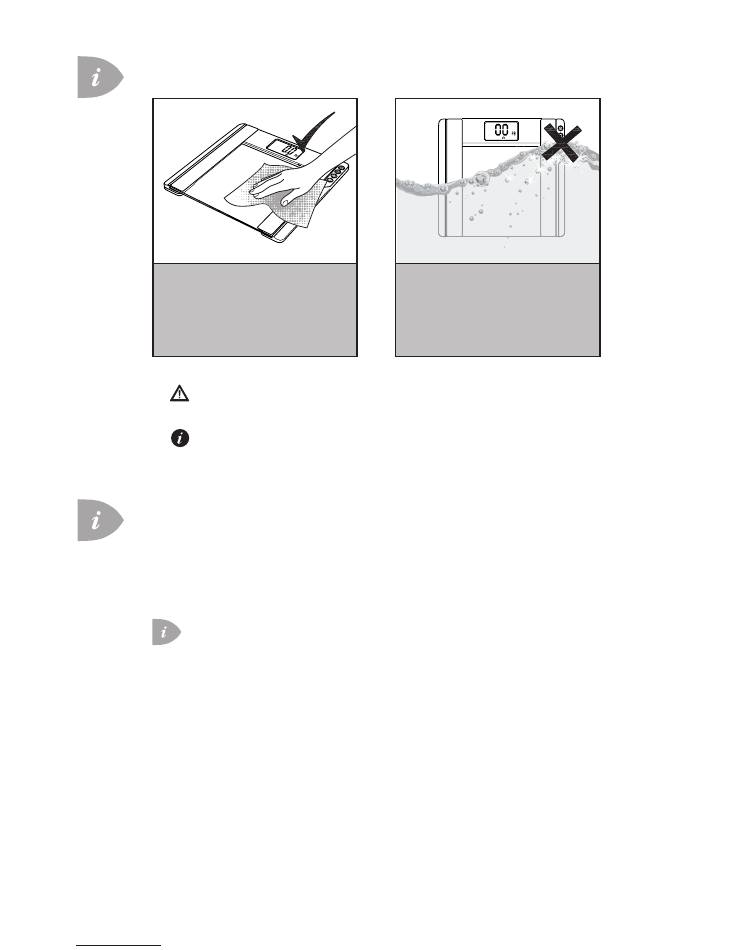
cm
Never immerse the scale in water or
rinse it under running water.
CARE
DO NOT store the scale in an upright position when not in use
– this will drain the batteries.
Treat your scale with care – it is a precision instrument. DO NOT drop it or
jump on it.
ADDITIONAL INFORMATION
Your new body fate scale allows you to measure weight, body fat percentage, water
percentage, muscle percentage and bone weight simultaneously and easily, simply
by stepping on the scale.
SPECIFICATIONS
•
Equipped with a High Precision “Strain-Gauge” Sensor
•
Tempered Safety Plate Glass Platform
•
Personal data can be pre-set and stored in 10 personal data memories
•
Capacity 150kg
•
Division 100g/0.2lb
•
LCD Display
•
Foot tap start or Key press on
•
Automatic zero resetting
•
Automatic switch off
•
Overload indicator
•
Low battery indicator
The scale should periodically be
cleaned with a damp cloth and a
small amount of soap.
DO NOT use strong or corrosive
cleaning agents.
12

POWER SUPPLY
•
Included 2 x Lithium Batteries (CR2032)
Please remove the insulation sheet from the battery contacts before use.
Replace the batteries when the scale shows
WARRANTY
This scale is warranted to be free of defects in workmanship and materials for a
period of 1 (one) year from date of purchase. Proof of purchase is required to
validate claims, so please retain yours.
Before discarding packaging, please ascertain that this product is what is desired.
Opening the packaging is considered acceptance that this product is suitable for
use.
13